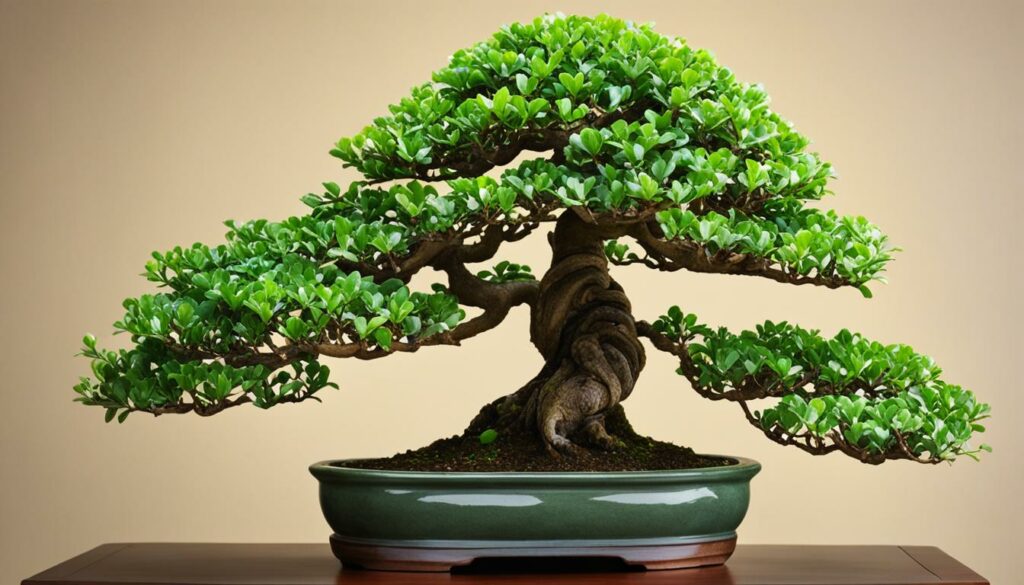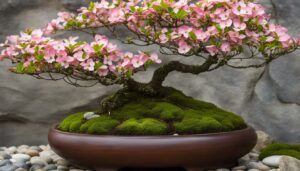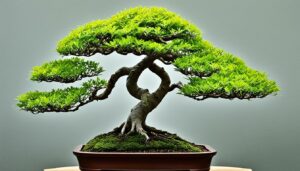If you’re a home gardening enthusiast, you may be familiar with the art of bonsai tree species. One of the most captivating bonsai tree species to grow in your indoor or outdoor space is the Jade Tree. Also known as Crassula Ovata, this species is highly resilient and has become a popular choice for succulent bonsai plants.
The Jade Tree is highly valued for its symbolization of calmness and tranquility, making it a perfect addition to any space that requires a serene atmosphere. Its ability to thrive in different environments makes it ideal for those who want to add some greenery to their home but don’t have the time or patience to maintain high-maintenance plants.
Key Takeaways
- The Jade Tree is a popular bonsai tree species valued for its resilience and tranquility.
- Also known as Crassula Ovata, the Jade Tree is a succulent bonsai plant that can thrive in different environments.
- The Jade Tree symbolizes calmness and is perfect for adding a serene atmosphere to any indoor or outdoor space.
- The Jade Tree requires minimal maintenance, making it easy to care for, even for novice home gardeners.
- Its striking features and aesthetic value can be enhanced through various styling techniques, pruning methods and creative displays.
Understanding the Jade Tree: Crassula Ovata
When exploring the world of Bonsai Trees, the Jade Tree, also known as Crassula Ovata, is one of the most popular varieties. This succulent plant has thick, round leaves and small white or pink flowers that bloom in the late winter or early spring.
To keep your Jade Tree healthy and thriving, it’s important to understand its care requirements. First and foremost, this plant is native to South Africa and requires bright light, but not direct sunlight, to grow and thrive. Therefore, it’s best to place it in a spot that receives plenty of natural light, such as a south-facing window. Additionally, you should ensure that the soil is well-draining and that you don’t overwater your plant.
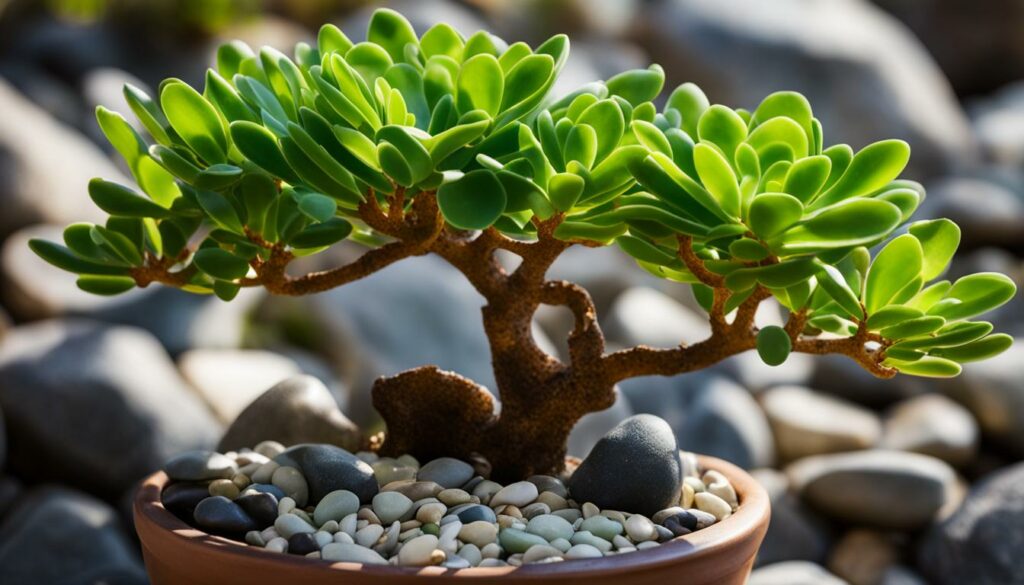
One of the unique characteristics of the Jade Tree is its ability to grow both indoors and outdoors. In warmer climates, it can be planted outside and left to grow freely, but in cooler climates, it’s best to keep it inside.
The Charm of Jade Tree Bonsai
If you’re looking for a succulent bonsai option, Jade Tree Bonsai is an excellent choice. These bonsai plants have striking features, making them an attractive addition to your home or garden. With proper jade care, they can thrive in various environments.
Jade Tree Bonsai comes in different varieties, and each has unique characteristics that appeal to plant enthusiasts. For example, the “Gollum” crassula ovata is a striking, sculptural variety with tubular, trumpet-shaped leaves. The “Campfire” crassula ovata features green leaves that turn orange and red in sunlight, while the “Hobbit” crassula ovata has rounded leaves with red margins.
Did You Know? The Jade Tree Bonsai is also known as the “Money Tree” or “Lucky Tree” and is believed to bring good luck and prosperity to the owner.
Aside from their unique appearance, Jade Tree Bonsai is easy to maintain. They are hardy and can withstand less-than-ideal growing conditions. However, to ensure that they grow healthy and vibrant, it is important to keep them in well-draining soil, water them thoroughly but not too frequently, and provide them with enough sunlight. Pruning is also crucial in shaping the bonsai and keeping it healthy and vibrant.
Figure 1: A beautiful Jade Tree Bonsai perfect for indoor and outdoor spaces
Nurturing the Jade Tree Bonsai: Care Tips
To ensure the successful growth of your Jade Tree Bonsai, you should pay close attention to its care needs. Here are some tips to keep your succulent bonsai in excellent health:
Watering
The Crassula Ovata, also known as the Jade Tree, is a succulent plant that requires infrequent watering. Water your bonsai when the soil in the pot feels dry to the touch. Make sure to avoid overwatering, as this can lead to root rot and other issues.
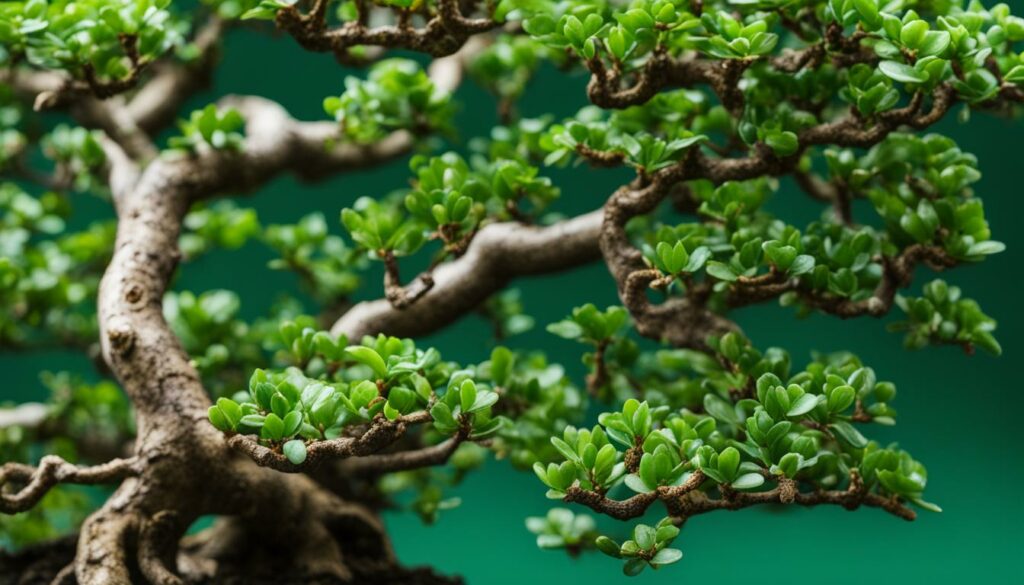
Light Requirements
Jade Tree Bonsai requires bright, indirect sunlight to thrive. Position your bonsai near a sunny window, taking care to avoid direct sunlight as it can scorch the leaves. If you don’t have access to adequate natural light, you can use grow lights as an alternative.
Soil
Use well-draining soil suitable for succulent plants like cacti and jade plants. You can also add perlite or sand to the soil mix for better drainage.
Pruning
Regular pruning is essential to keep your Jade Tree Bonsai in shape and to promote healthy growth. Prune away any dead or damaged leaves or branches and shape your bonsai tree as desired.
Maintenance
Regular maintenance is important to keep your Jade Tree Bonsai healthy and thriving. Check your bonsai plant frequently for signs of pests or disease, and address any issues promptly. Additionally, fertilize your bonsai with a balanced fertilizer once a month during its growing season.
By following these care tips, you can ensure that your Crassula Ovata Jade Tree Bonsai thrives and adds a calm, serene ambiance to your indoor or outdoor space.
Common Challenges and Solutions for Jade Tree Bonsai
Caring for a Jade Tree Bonsai can be a rewarding experience. However, it’s not without its challenges. Here are some common issues you might encounter and practical solutions:
Pests
Jade Tree Bonsai are generally hardy plants, but they can sometimes attract pests such as spider mites, mealybugs, and scale insects.
To combat pests:
- Wipe down the leaves with a damp cloth to remove any visible pests.
- Apply a natural insecticide spray, such as neem oil, to the affected areas.
- Keep the plant well-hydrated and avoid fertilizing during a pest infestation, as it can stress the plant further.
Diseases
Jade Tree Bonsai rarely suffer from diseases, but they can be susceptible to root rot if they’re overwatered or planted in poorly-draining soil.
To prevent root rot:
- Make sure the pot has proper drainage holes and use well-draining soil with a mixture of sand, perlite, and peat moss.
- Water the plant only when the soil is dry to the touch, and be careful not to let the water accumulate in the saucer below the pot.
- If you suspect root rot has set in, remove the plant from the pot, trim away any soft, rotten roots, and repot in fresh soil.
Leaf Drop
Leaf drop can be a common problem in Jade Tree Bonsai, which can be caused by several factors such as improper watering, too much or too little light, or sudden changes in temperature.
To combat leaf drop:
- Make sure the plant is getting adequate light, as well as a consistent temperature range of 60-75°F.
- Water the plant when the soil is dry to the touch, but avoid overwatering or letting the plant sit in water for an extended period.
- Use a humidifier or place a tray of water near the plant to increase the humidity levels, as dry air can contribute to leaf drop.
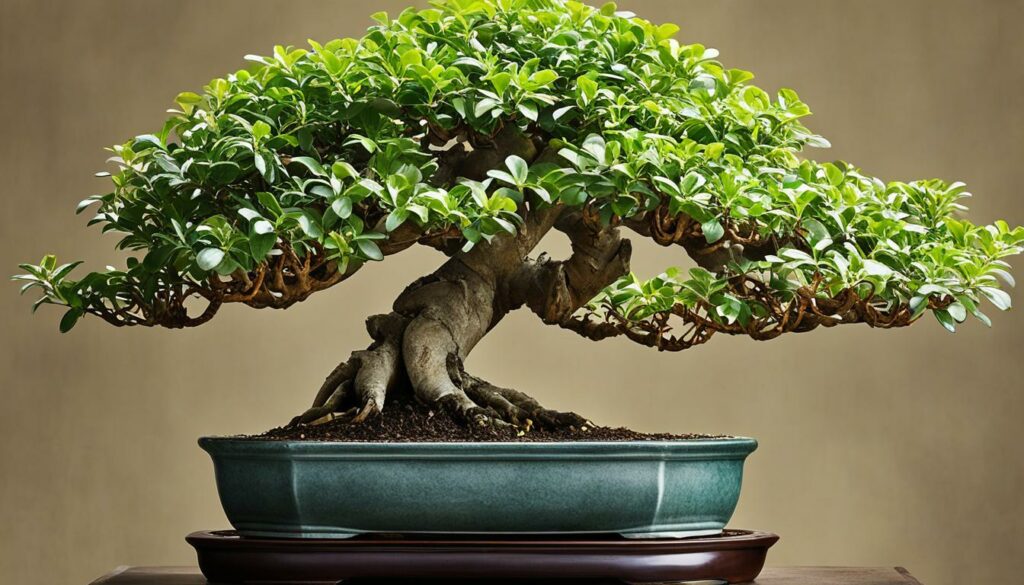
Styling Techniques and Pruning for Jade Tree Bonsai
As you perfect your Jade Tree Bonsai care techniques, you can try your hand at styling and pruning this resilient succulent bonsai. Shaping, wiring, and branch development are some of the most-used methods to customize the tree’s design, depending on your creative preferences and the character of your bonsai. Here are some practical tips to help you master these techniques:
Shaping
Shaping involves guiding the growth of your Jade Tree Bonsai to reflect a particular aesthetic or style. You can create various shapes, including cascading, formal, and informal upright, as well as broom and windswept styles.
Using wire to shape your bonsai is one of the most common and effective techniques. Wind the wire around the branches to make them grow in the desired direction. However, take care to avoid damaging the bark and breaking the branches. You can use a branch bender to hold the branches in the right position while wiring them. Keep tabs on the wire as the tree grows to avoid it digging into the branches – it may take a few months before you can release the wiring carefully.
Trimming your Jade Tree Bonsai’s branches and leaves also helps in shaping and achieving a polished look. Focus on removing any undesired branches and leaves, including those that might turn out to be weak or not in harmony with the overall design and style.
Wiring
Wiring your Jade Tree Bonsai is essential when shaping and changing its angles, curves, and overall appearance. Copper or aluminum wire works best, but it should not be too thick or too thin – a gauge of 1.5-2mm is ideal. Check the wire often to avoid it digging in and biting into the branches. You may need to adjust the wire continually as the bonsai grows.
Branch development
Branch development is a fundamental technique that helps your Jade Tree Bonsai grow in specific patterns and directions. Creating well-spaced, healthy splits in the branches is one of the most effective ways to stunt branch growth. Keep in mind that not all Jade Tree Bonsai species require splitting to achieve these effects – some naturally grow in these patterns.
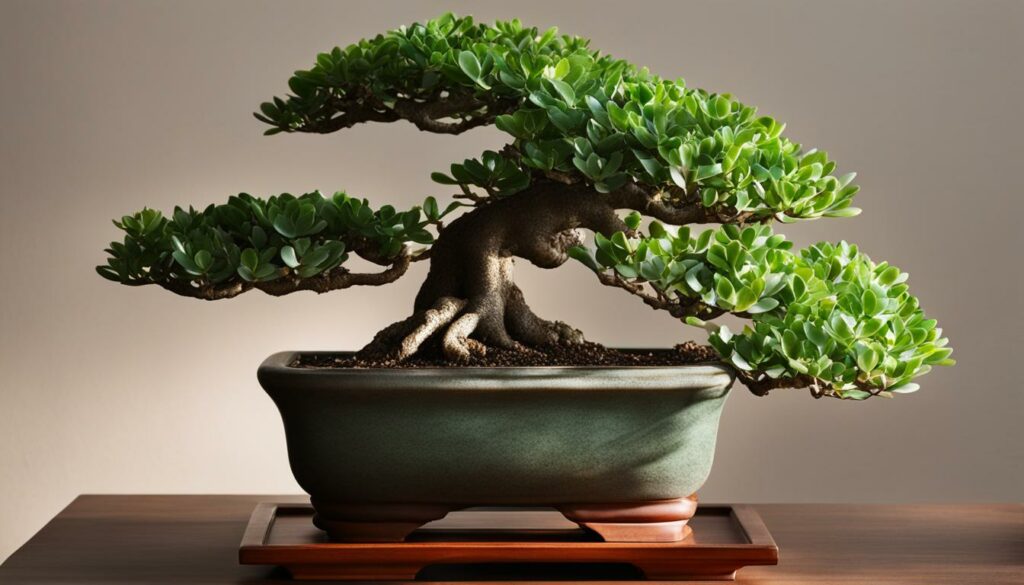
“When shaping your Jade Tree Bonsai, make small adjustments often and gradually; do not bend the branches too far at once.”
Overall, styling and pruning the Jade Tree Bonsai call for patience, knowledge, and expertise. Start with simple techniques such as trimming and wiring before moving onto more complex methods such as shaping and branch development. As a beginner, research more and experiment more to unlock the bonsai’s full potential.
Displaying and Presenting Jade Tree Bonsai
As succulent bonsai plants, Jade Trees offer a unique aesthetic appeal to any indoor or outdoor space. To fully showcase the beauty of your Jade Tree Bonsai, it is crucial to display and present it appropriately.
Choosing a Pot
Your choice of pot can significantly affect the overall impression of your Jade Tree Bonsai. It is recommended to select a pot that is slightly bigger than the root ball, allowing room for growth. Ceramic, clay, and terra cotta pots are great options that provide excellent drainage for your succulent bonsai.
Using a Stand
When it comes to displaying your Jade Tree Bonsai, using a stand can elevate its beauty to new heights. Bonsai stands come in various shapes and sizes, and you can even create your own using natural wood or stones. Choose a stand that complements the color and shape of your Jade Tree Bonsai.
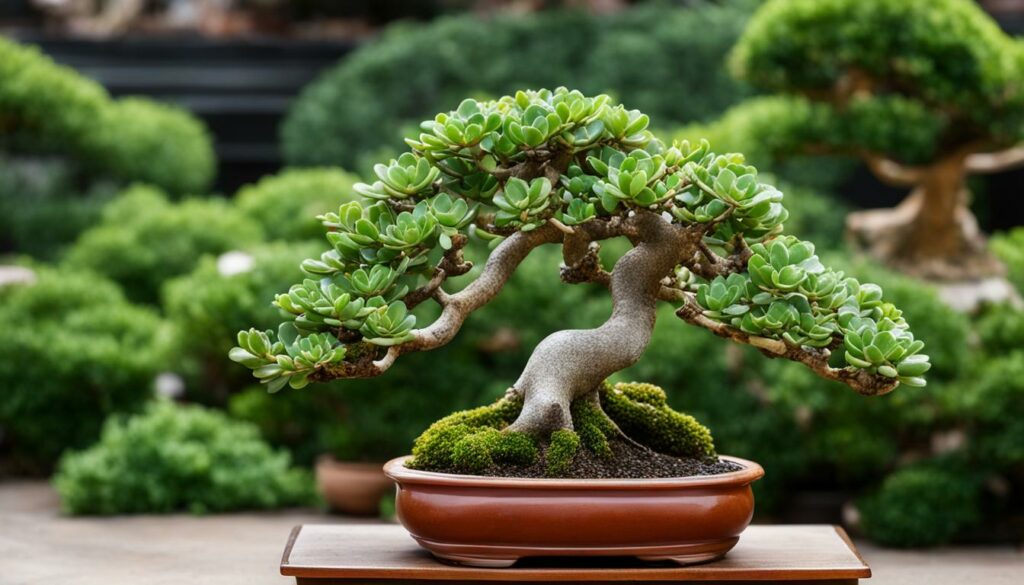
Complementary Arrangements
Complementing your Jade Tree Bonsai with additional plants or decorative elements can enhance its visual appeal. You can include other succulents or plants that thrive in similar lighting and soil requirements. You can also use decorative elements, such as rocks, sand, or moss, to add texture and visual interest.
Final Thoughts
Displaying and presenting your Jade Tree Bonsai is an artform that requires attention to detail and creativity. By following these tips, you can create a beautiful and harmonious display that captures the tranquility and resilience that the Jade Tree represents.
Conclusion
Now that you have explored the fascinating world of the Jade Tree Bonsai, you have discovered the many benefits of cultivating this resilient and tranquil species. With its striking features and ability to thrive in different environments, Jade Tree Bonsai is an excellent addition to your indoor or outdoor spaces.
You have also learned about the essential care requirements and common challenges when nurturing your bonsai. Remember to provide adequate watering, light, soil, and pruning to ensure healthy growth.
By following the styling techniques and pruning methods we discussed, you can create stunning designs that showcase the beauty of your Jade Tree Bonsai. And with creative ideas for presenting and displaying your bonsai, you can share the captivating charm of this succulent tree with others.
In conclusion, we hope that this article has provided you with valuable insights and practical tips for growing and caring for your Jade Tree Bonsai. Start your home gardening adventure with this remarkable tree today and enjoy the tranquility and resilience it brings to your space.
FAQ
What is the Jade Tree?
The Jade Tree, scientifically known as Crassula Ovata, is a popular succulent bonsai species. It is characterized by its thick, fleshy leaves and a sturdy trunk that stores water, making it highly resilient and low-maintenance.
How do I care for a Jade Tree Bonsai?
To care for a Jade Tree Bonsai, you should place it in a well-lit area, provide moderate watering when the soil is dry, use well-draining soil, and avoid overwatering. Pruning should be done regularly to maintain its desired shape and keep it healthy.
Can I grow Jade Tree Bonsai indoors?
Yes, Jade Tree Bonsai can thrive indoors as long as they receive adequate sunlight. Place them near a south-facing window or use artificial grow lights to ensure they get the necessary light. They also prefer temperatures between 65-75°F (18-24°C).
How often should I water my Jade Tree Bonsai?
Jade Tree Bonsai prefer to dry out slightly between waterings. It is recommended to water thoroughly when the soil feels dry to the touch, usually every 10-14 days. Overwatering can lead to root rot, so it’s essential to ensure proper drainage.
How do I prevent pests on my Jade Tree Bonsai?
Inspect your Jade Tree Bonsai regularly for pests such as aphids, mealybugs, or spider mites. If you spot any, use a mild insecticidal soap or a neem oil solution to control the infestation. Keeping the bonsai clean and healthy will also help prevent pest problems.
Can I propagate my Jade Tree Bonsai?
Yes, you can propagate Jade Tree Bonsai through leaf or stem cuttings. Simply allow the cuttings to callous over for a few days, then plant them in well-draining soil. Keep the soil lightly moist until new roots develop.
How often should I fertilize my Jade Tree Bonsai?
Jade Tree Bonsai should be fertilized once a month during the active growing season, typically from spring to early autumn. Use a balanced, water-soluble fertilizer at half the recommended strength to avoid overfeeding.
Can I shape my Jade Tree Bonsai with wiring?
Yes, you can shape your Jade Tree Bonsai using wiring techniques. However, it is crucial to use caution and avoid wiring branches that are too thick or brittle. Be gentle when bending to prevent damage and regularly check and adjust the wire to prevent scarring.
